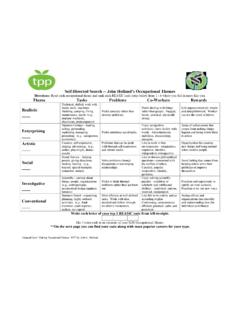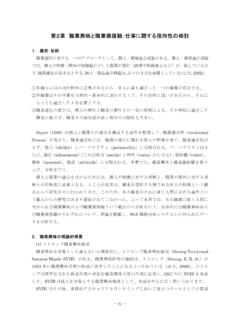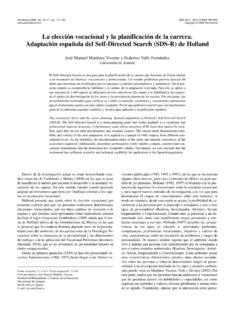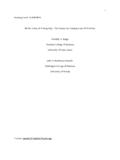Transcription of Personality and Leader Effectiveness: A Moderated ...
1 Personality and Leader effectiveness : A Moderated Mediation Model ofLeadership self -Efficacy, Job Demands, and Job AutonomyKok-Yee Ng and Soon AngNanyang Technological UniversityKim-Yin ChanSingapore Armed Forces and Nanyang Technological UniversityThe trait theory of leadership is advanced by a joint investigation of the mediating role of (a) leadershipself-efficacy (LSE Leader s perceived capabilities to perform Leader roles) in linking neuroticism,extraversion, and conscientiousness with Leader effectiveness and (b) the moderating role of job demandsand job autonomy in influencing the mediation. Using K. J. Preacher, D. D. Rucker, and A. F. Hayes (2007) Moderated mediation framework, the authors tested the model (over a 2-year period) with matcheddata from 394 military leaders and their supervisors. Results showed that LSE mediated the relationshipsfor neuroticism, extraversion, and conscientiousness with Leader effectiveness .
2 Moderated mediationanalyses further revealed that LSE mediated the relationships for (a) all 3 Personality variables for onlythose leaders with low job demands; (b) neuroticism and conscientiousness for only those leaders withhigh job autonomy; and (c) extraversion, regardless of a Leader s level of job autonomy. Resultsunderscore the importance of accounting for leaders situational contexts when examining the relation-ships between Personality , LSE, and : self -efficacy, Personality , job demands, job autonomy, Moderated mediationJudge, Bono, Ilies, and Gerhardt s (2002) meta-analysis on thetrait perspective of leadership found that neuroticism ( .22)was negatively correlated and that extraversion ( .24), open-ness ( .24), and conscientiousness ( .16) were positivelycorrelated with Leader effectiveness . Agreeableness, which Judgeet al. argued to be an ambivalent trait for leadership, was alsopositively associated with Leader effectiveness (.)
3 21). Overall,the Big Five had a multiple correlation of .39 with Leader effec-tiveness, which prompted Judge et al. (2002) to conclude that the Big Five typology is a fruitful basis for examining the disposi-tional predictors of leadership (p. 773).Notwithstanding these promising results of the trait theory ofleadership, Judge et al. (2002) raised two major concerns thatrequire further research. First, they identified that the processthrough which Personality affects Leader outcomes remains under-explored and that this situation results in a poor understanding ofhow distal traits translate into Leader effectiveness . Despite Judgeet al. s (2002) call for future research to explain the linkagesbetween the Big Five traits and leadership (p. 774), very fewstudies to date have examined the theoretical mechanisms that linkpersonality traits and Leader on Personality (Barrick & Mount, 2005; McCrae &Costa, 1996) and motivation (Kanfer, 1990) has asserted that theeffects of distal traits, such as those of Personality on workbehaviors, are mediated through more proximal motivationalstates.
4 For example, Barrick and Mount (2005) advanced the ideathat the primary means through which Personality affects workbehavior is expected to bethrough motivation[italics added] ( ). Of the various motivational concepts, social cognitive the-ory (Bandura, 1997) has identified self -efficacy as the most pow-erful self -regulatory mechanism in affecting behaviors. Stajkovicand Luthans (1998) large-scale meta-analysis demonstrated thatefficacy beliefs specific to a particular task are critical for theprediction of performance in a given situation. Locke (2003)likewise commented that self -efficacy has proven to be extraor-dinarily useful as a motivation concept in numerous domains ofhuman functioning (p. 441). Given that Personality research hashighlighted the importance of motivational processes and thatself-efficacy is a central motivational construct for prediction ofbehaviors, we posit leadership self -efficacy (LSE), a specific formof efficacy beliefs related to leadership behaviors, as a key moti-vational mechanism that links leaders broad Personality traits toleader second concern of the trait theory of leadership pertains tothe role of situations (Judge et al.)
5 , 2002). Although situations havelong been recognized as abetting or constraining human agency(Johns, 2006; Mischel, 1968), the trait theory of leadership islargely silent on the influence of the situational context surround-ing the Leader , which could moderate the predictive validity of thetheory (Judge et al., 2002; McAdams, 1992). A recent review onpersonality and leadership by Spangler, House, and Palrecha(2004) concluded that perhaps the major limitation of the [BigFive] model, with respect to leadership research, is that it does notspecify the conditions under which specific traits operate (p. 257).Recently, Hambrick, Finkelstein, and Mooney (2005) directedleadership research toward addressing the missing role of jobcontexts, in particular, the unique task and performance challengesKok-Yee Ng and Soon Ang, Division of Strategy, Management, andOrganization, Nanyang Technological University, Singapore; Kim-YinChan, Singapore Armed Forces and Division of Strategy, Management,and Organization, Nanyang Technological thank Sasha Chernyshenko for his helpful comments on an earlierversion of this concerning this article should be addressed to Kok-YeeNg, Nanyang Business School, Nanyang Technological University, Singa-pore 639798.
6 E-mail: of Applied PsychologyCopyright 2008 by the American Psychological Association2008, Vol. 93, No. 4, 733 7430021-9010/08/$ DOI: with leaders jobs. On the basis of Karasek s (1979)classic work on job strain, Hambrick et al. identified job demandsand lack of job autonomy as key challenging elements in theleaders job context that could induce deleterious performanceconsequences but that have been understudied in leadership re-search. Building on Hambrick et al. s recommendations, we ex-amined the extent to which the job demands and job autonomyexperienced by leaders moderate the relationships between per-sonality, LSE, and , we developed a Moderated mediation model ( , Baron& Kenny, 1986; Edwards & Lambert, 2007; Muller, Judd, &Yzerbyt, 2005; Preacher, Rucker, & Hayes, 2007), which jointlyexamines LSE as the mediating mechanism and job demands andjob autonomy as the moderators, to enhance the theoretical validityand precision of the trait theory of leadership.
7 In the next section,we draw on Kanfer s (1990) distal proximal framework of moti-vational theories and Tett and Burnett s (2003) trait activationtheory to substantiate our Moderated mediated model of traittheory of leadership and the hypotheses associated with the Preacher et al. s (2007) analytical procedures, we report amoderated mediation test of our model that used field data col-lected from matched pairs of leaders and their supervisors in Background and HypothesesLSELSE refers to the perceived capabilities of the individual toperform functions necessary to accomplish specific leadershiproles effectively (Chemers, Watson, & May, 2000; Kane, Zaccaro,Tremble, & Masuda, 2002). Consistent with the theoretical andempirical distinction made between task-specific versus generalself-efficacy (Chen, Gully, & Eden, 2001; Chen, Gully, Whiteman,& Kilcullen, 2000), LSE is a specific form of efficacy beliefstargeted at leadership behaviors.
8 It is distinct from general self -efficacy, which involves belief in one s overall competence in awide range of achievement situations (Eden, 2001; Eden & Kinnar,1991). Similarly, the task specificity of LSE differentiates it con-ceptually from the Big Five Personality traits, which are broaddispositions that exert a generalized influence on behaviors acrosssettings (Mischel, 1968).On the basis of the theory of self -efficacy (Bandura, 1977,1997), we expected leaders with greater LSE to be more effectiveleaders, because they are inclined to expend greater efforts tofulfill their leadership roles and to persevere longer when facedwith difficulties. Despite the relevance of LSE for leadership, onlythree studies to date have examined the relationship between LSEand Leader effectiveness . Chemers et al. (2000) found that ROTC cadets who reported higher LSE were given more positive Leader -ship ratings by their instructors, peers, and trained observers in a6-week leadership training camp.
9 Paglis and Green (2002) simi-larly found that managers who had greater confidence in settingdirections and gaining commitment were rated by their subordi-nates as having made more attempts at leading change. Finally, alaboratory experiment by Kane et al. (2002) demonstrated thatleaders with greater LSE set higher goals and had better taskstrategies, which in turn led to better group Mediating Role of LSEOf greater interest in our model is the mediating role of LSE inexplaining the distal relationships between the Big Five traits andleader effectiveness . Consistent with Personality research that callsfor a more specific matching of Personality traits with the criteriaand context of research (Barrick & Mount, 2005; J. Hogan &Holland, 2003), we focused on Personality traits that are mostrelevant to our study of leadership effectiveness in the militarycontext. The meta-analysis by Judge et al. (2002) found that onlyneuroticism, extraversion, and conscientiousness were significantpredictors of leadership for studies conducted in a government andmilitary setting.
10 This finding supports previous research that hasfound mixed and conflicting results for the relationship betweenagreeableness and Leader effectiveness . Results are mixed becausethe prosocial aspect of agreeable leaders should enhance theireffectiveness in managing interpersonal relationships, but the de-sire to please others and to avoid conflict may make it difficult forthem to make hard decisions (Graziano & Eisenberg, 1997). Open-ness to experience, which involves being imaginative, sensitive toaesthetics, and open to new ideas, has been found to be importantfor jobs that require creativity (George & Zhou, 2001) and adapt-ability to change (LePine, Colquitt, & Erez, 2000). However, it isless directly relevant to leadership in the military context, whereadherence to rules and hierarchy is with these established findings, we focused on thetraits of neuroticism, extraversion, and conscientiousness.






